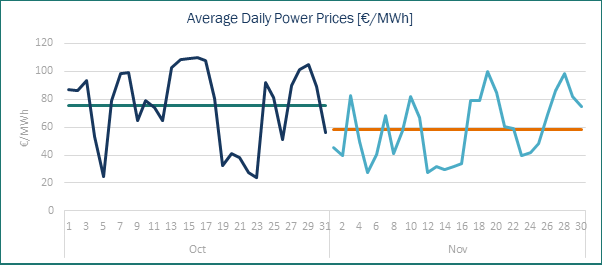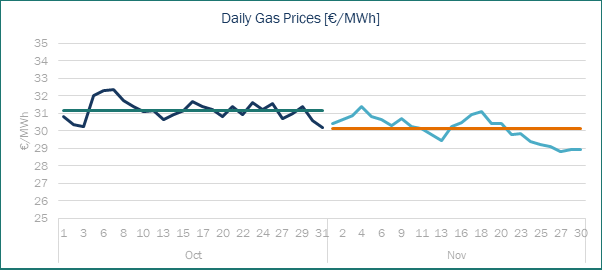Spanish Market Analysis
Analysis of the Spanish energy market is key to understanding the dynamics and trends affecting the sector both locally and internationally. In this detailed analysis, we address the important factors influencing energy prices, supply and demand, and the latest regulatory policies. This comprehensive overview will allow you to keep up to date with weekly changes and anticipate possible market variations, both in Spain and in other relevant markets such as France.
November 2025
Key figures of the month
Table of Contents
Key figures of the month

Main takeaways
During the last month, electricity spot prices in European markets have differed from those in previous month. Spain has experienced a significant downward trend, while France, Italy and the UK have shown similar prices. Germany has experienced a significant upward trend compared to the previous month. However, looking at Power Cal’26, we can see that all countries have experienced a downward trend compared with the previous month.
Spain has overtaken France to become the country with the lowest prices on the continent, averaging 58.65 €/MWh. France follows closely behind with a similar price of 59.13 €/MWh, while the UK is in third place with an average price of 88.49 €/MWh.
Throughout November, electricity prices in the main European markets were largely driven by the evolution of renewable generation, particularly wind. In the first week, there was a general decline in wind output across most markets, except in the Spanish system, where production remained more stable. This helped Spanish market to contain prices and support a downward trend.
During the second week, an increase in solar PV generation, combined with a decline in gas prices, led to prices falling across all markets. However, this pattern reversed in the third week, when falling temperatures pushed up demand at the same time as renewable output decreased, resulting in a renewed upward pressure on prices.
In the last week of November, prices were above 95 €/MWh in most European power markets. The Spanish and French markets were the exceptions; however, several markets recorded their highest daily prices in recent months despite an increase in wind generation that only partially offset the drop in solar output.
On 28th November, gas futures fell to their lowest level since last year, while CO₂ futures reached their highest level since early February. This combination sent mixed signals regarding price formation: lower gas costs provided some relief for gas-fired technologies, but the rise in carbon prices increased costs for the most carbon-intensive plants. This contributed to maintaining electricity prices at relatively high levels in many European markets.
Energy demand and generation mix

In November 2025, electricity demand in Spain reached 20,727 GWh, while total generation amounted to 22,329 GWh. Of this output, approximately 1,602 GWh were scheduled for export to other countries.
Compared with October 2025, there was an increase in both electricity demand and generation over the same period. In year-on-year terms, demand grew by a significant 4.2% in November 2025 versus November 2024. Cumulatively, electricity demand in Spain has reached 232,851 GWh so far this year, which is 2.5% higher than in the same period in 2024.
In November 2025, renewable energy sources accounted for 56.6% of the total mix, generating 21.9% more than in the same month of 2024.
The main source of generation was wind, contributing 31.1% of total output, significantly higher than the 20.8% recorded in October and the 23.7% observed in the same month of the previous year. Wind power has contributed more during key periods such as early mornings, daylight hours and dusk, replacing gas-based technologies and making November a cheaper month than the previous one.
Second place went to CCGT, representing 18.4% of the national mix after leading the ranking the previous month, followed by nuclear with 16.4%. Regarding nuclear technology, the most notable event of the month was the return to operation of Unit 2 at Almaraz, which was reconnected to the electricity grid after successfully completing the scheduled maintenance activities for its 29th refuelling outage. In addition, Cofrentes nuclear power plant experienced an unplanned shutdown on 10 November 2025 following the automatic actuation of the turbogenerator protection system, triggered by an electrical fault in one of the equipment phases.
The fourth technology in the accounting ranking was PV, and it experienced a monthly decline (down to 14.1% from 18.4% in October). However, if compared with the same month of the previous year, we can see an increase (from 11.4% in November 2024). In addition, once PV generation from November was included, the total PV generation for this year has surpassed the entire 2024 solar photovoltaic generation.

Source: Haya Energy Solutions
Energy prices & market panorama

Source: Haya Energy Solutions
In November 2025, the average wholesale electricity price in Spain stood at 58.65 €/MWh. This figure represents a 23% decrease compared to October, driven mainly by higher wind electricity generation during the month. November was the second month with the 15 minutes system in place, meaning a shift from 24 to 96 prices per day.
The month was characterized by high price dispersion, reflecting system volatility. There were days with very low prices—such as November 5 and 12, when the average price did not exceed 28 €/MWh, contrasting with other periods (November 19th and 28th) when the daily average price approached 100 €/MWh. This pronounced variability highlights the increasing sensitivity of the market to weather conditions and renewable generation availability.
In November 2025, the average natural gas price in the Spanish market stood at 30.12 €/MWh, slightly below the 31.18 €/MWh recorded in October, representing a decline compared to the previous month.
The most notable feature of the period was the sustained downward trend in prices observed from the middle of the month onwards. The curve shows two distinct peaks, each followed by a similar downward movement, indicating a recurring pattern of correction after short-lived spikes. This decline reflects relative stability: the market evolved orderly, with a balanced supply and demand, and there was no significant stress in international gas markets. In addition, market sentiment around the possibility of progress toward a peace agreement in the Ukraine conflict contributed to reducing pressure on prices.

Market trends and futures

Source: Haya Energy Solutions
During November 2025, Spanish electricity forward prices were characterised by a generalised decline. The most notable movement was a 7.3% decline in December 2025. This is expected to be due to soft temperatures in the first half of the month, as well as the downward trend in gas prices.
In the gas market, significant declines were observed across all products and time horizons analysed, as now gas market hasn’t got any relevant tension. This downward trend was supported by external factors, such as the possibility of increased crude oil offers if sanctions against Russia were lifted in the event of a peace agreement being reached on the war in Ukraine. Moreover, production in Norway remained stable without any notable issue.
Regarding storage levels, natural gas reserves in the European Union currently stand at 75.75% of capacity, notably lower than the 90% fixed as objective. This figure is particularly relevant as winter approaches, when gas consumption typically rises due to heating demand. In Spain, gas reserves currently stand at 83.61%, compared to 93.58% in the same period of 2024.
It is worth noting that since July 2025, the European Parliament has relaxed the 90% minimum storage requirement, allowing Member States to reach this target at any point between 1st October and 1st December each year. Once the threshold is achieved, it is no longer mandatory to maintain it until year-end, providing countries with greater operational flexibility.
Finally, EU carbon allowance (EUA) forward prices for December 2025 and December 2026 showed a 3% increase compared to the previous month. This upward movement continues to put pressure on carbon-intensive technologies and could exert upward influence on electricity prices in the medium term.
Regarding new regulations in Spain, the RD 997/2025 was published last November 6th to strengthen the grid energy system. Its main intentions include an increase of reports and inspections for all participants in the supply chain (generators, operators, distributors), improvements required within the next 6 months to enhance grid stability, changes to the calculation of installed capacity for generation and storage assets, identification of batteries as key areas for improvement integrated into the PNIEC, and efforts to reduce bureaucratic delays for new energy.
In the first semester of 2026, the active response demand system will require a total of 1,725 MW of power to support increased flexibility. This amount has increased by 50% compared to 2025 and represents 74% of the total power needed during the first semester, which is 2,339 MW. Part of the updates for the next year are:
- Semestral period instead of annual.
- Consumers that are able to operate in the market and have at least 1MW of power capacity.
- The duration switches to 2 hours period and a shorter notice period of 12.5 minutes rather than the previous 3 hours and 15 minutes respectively.
SP Baseload Power price (€/MWh)
SP Peak load Power price (€/MWh)
EUA price (€/t)
MIBGas price (€/MWh)
Coal Price ($/Tn)
Gas efficiency: 52%
Coal efficiency: 38%
Gas vs. Coal Price (€/MWh)
Gas efficiency: 52%
Coal efficiency: 38%




